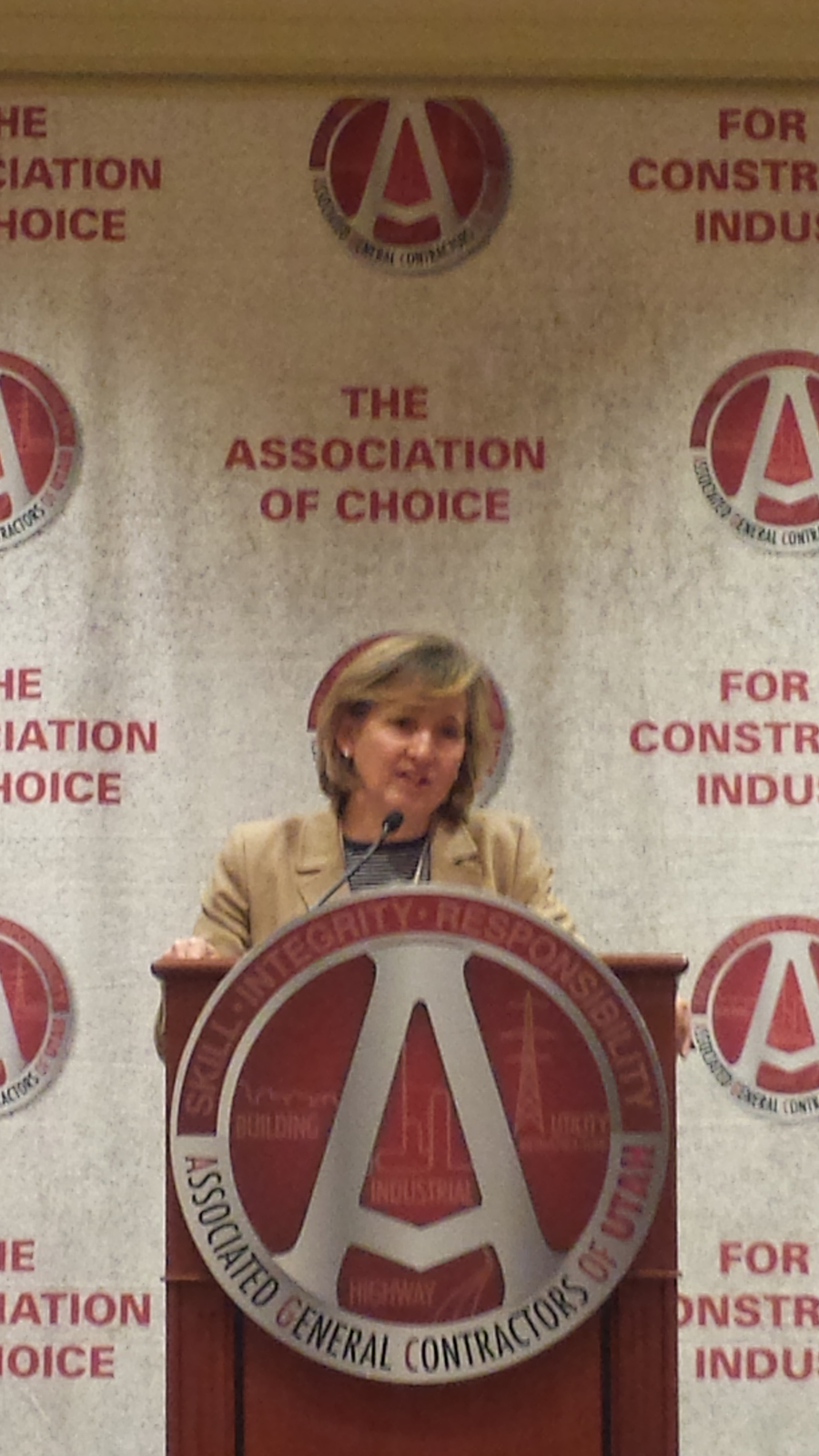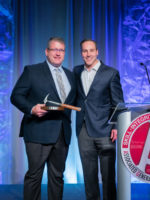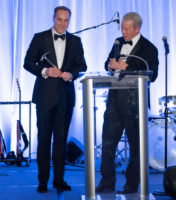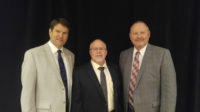Convention Coverage
Utah AGC Members Anticipate Another Solid Year for the State’s Contracting Business

Economist Natalie Gochnour tells AGC Utah members at their annual convention that nonresidential construction spending in the state last year reached a historic high of $2.5 billion.
Photo by Brian Fryer
Members of the Utah Chapter of the Associated General Contractors of America touted the strength of the regional construction industry during their 95th annual convention on January 19-21 at Salt Lake City’s Little America Hotel.
The group also unveiled the initial phase of a new program to recruit workers to the construction industry and installed Michael Kurz of Oldcastle Materials as its 2017 chairman. Kurz succeeds Dave Hogan of Wadman Corp. in the role.
Most contractors at the convention say they are looking forward to a year of solid backlogs, with many more projects slated to bid in the near future.
“2016 was a pretty good year. Most of the contractors, subs and suppliers are busy, and they are optimistic,” said AGC Utah President Rich Thorn. “I recently hosted a meeting of about 25 leaders from the top contractors, and all of them said they’d had a busy year and have a good backlog on the books and work coming up to bid on.”
Company leaders such as Rob Moore, CEO of Salt Lake City-based Big-D Construction, Mike Whitaker, president of Whitaker Construction of Brigham City, Jeff Clyde of Orem-based W.W. Clyde and Doug Welling, president of Salt Lake City-based Jacobsen Construction, confirmed Thorn’s optimistic assessment of 2016.
“Last year was record breaking in terms of revenue. We have about 11,000 employees across the country right now in nine offices,” said Moore. “We have become more of a national contractor. We have repeat business with clients who take us with them wherever they are building, and that is really what we want.”
Big-D also is currently engaged in project management joint ventures at two of the largest long-term projects underway in Utah—the nearly $2-billion replacement of Salt Lake International Airport’s main terminal and the $550-million construction of a new state prison.
Clyde said that civil and heavy-highway contractor W.W. Clyde also had record revenues in 2016 as it celebrated the company’s 90th year in business and opened a new corporate headquarters building.
“We did a large job for Rio Tinto, working on an expansion of the Kennecott mine, and we also worked on a large wind-farm project in Wyoming,” he said. “We are watching for opportunities at the airport and at the new prison site in the coming year.”
Whitaker said that his firm’s launch of a new cured-in-place-pipe (CIPP) service line last year contributed to a year of record profits for the company. “It was a challenging year but a growth year for us,” said Whitaker. “The labor issues were a challenge, but with some aggressive hiring and getting some people from the gas and oil sector that had slowed down, we were able to get through. The new people all got through the learning curve pretty quickly, so that was helpful.”
2017 Outlook
Supporting the anecdotal evidence of recent industry success was convention guest speaker Natalie Gochnour, chief economist and senior adviser to the Salt Lake Chamber. She also is an associate dean of the David Eccles School of Business at the University of Utah.
“We have, if not the fastest-growing, then certainly in the top three fastest-growing economies, here in Utah,” Gochnour said. “Our unemployment rate is about 3.5% compared to 4.5% nationally.
Gochnour cited statistics from the latest Economic Report to the Governor that show the value of nonresidential construction in Utah was up 19% in 2016 over 2015, reaching a historic high of $2.5 billion.
But she also sounded a note of caution. “We have had an expansion over the past few years, and expansions don’t die of old age. They usually die when they are six to eight years old. We know a downturn will be coming, but we not sure exactly when.”
Gochnour forecasted a decline in nonresidential construction spending in 2017 to $1.9 billion, a figure still well above the state’s annual average of $1.6 billion since 2000.
New Workforce Campaign
The challenge of finding skilled and trained workers was another common theme at the convention. Thorn said the issue has been a top priority of 2016 Chairman Hogan and members and AGC leadership have been working to address it.
“The challenge for 2017 is going to be workforce, or the lack thereof,” said Thorn. “We’ve had this past year a workforce development committee working on this issue, and we’ve got a contract with a firm (Salt Lake-based advertising and public relations firm Intrepid Group). We are in the process of gathering data to create a campaign we’ll roll out in the coming year.”
During 2016 Thorn said the committee worked to identify potential groups for targeted messages and intensified its work with high school career guidance counselors.
“We are about 30% of the way into the process of developing this messaging campaign,” said Thorn. “We did get a chance to speak to the annual meeting of Utah high school counselors last year and made a presentation to them about the opportunities of a career in construction.”
Moore said Big-D, like many other contractors, has been engaged in its own outreach efforts to find new workers. “Right now we are finding that Utah, the state and culture and opportunities we have here, is one of the best recruiting tools we have,” he said. “We are finding people who grew up here or went to school here and left or maybe moved during the downturn, and now want to come back.”
Whitaker said his firm had done some “aggressive hiring” and pulled workers from the oil-and-gas sector when it slowed in recent years.
A Quiet Legislative Session
The Utah State Legislature opened its 2017 session on January 23, and Thorn said that, as usual, the association will be monitoring bills related to the construction industry, but no major issues have come up in pre-session meetings.
“Of course, we’ll be watching the appropriations for DFCM [State of Utah Division of Facilities and Construction Management] and UDOT, and things with the state parks,” he said.
“There has been some talk of putting together bonding for highway projects, some things that are on the list right now that could be moved up and done sooner to alleviate some pressure,” Thorn said. “Debt service has been ongoing, and there is some capacity that has been freed up. Money is cheap to borrow right now and the state has a triple-A bond rating, so we’ll be involved in those talks if that issue moves forward.”



